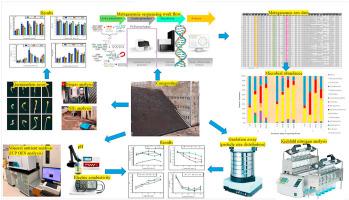Journal of Environmental Management ( IF 8.0 ) Pub Date : 2020-09-11 , DOI: 10.1016/j.jenvman.2020.111252 Ajuna B Henry 1 , Chaw Ei Htwe Maung 1 , Kil Yong Kim 1

|
Composting is a microbiological process that converts organic waste into organic soil amendment. We reveal enhanced biodiversity and microbial population with subsequent enhancement of composting efficiency of lignocellulosic waste using thermoacidophilic effective microorganisms (tEM). Composting with tEM + shading (tEMA) or tEM without shading (tEMB) increased the average microbial population by 12.0% or 6.7%, respectively compared to non-tEM composting without shading/control (C). The biodiversity in tEMA or tEMB treated groups was increased by 34.7% or 43.7%, respectively, compared to C. The highest increase in population (31.7% and 9.4%) and diversity (91.2% and 91.6%) were observed in tEMA and tEMB at 30 d, respectively. Regarding microbial structure, the most dominant phylum shifted from Proteobacteria to Bacteroidetes during composting. From 60 to 120 d, tEM notably improved the average abundance of Firmicutes (mainly Bacillus) by 166.7% and 75.8% in tEMA and tEMB groups, respectively. The overall gradation rate of large compost granules (<2 mm) increased by 36.4% and 24.7%, following tEMA and tEMB treatment, respectively. The average rate of increase in bulk density was 42.6% or 33.3% by tEMA or tEMB, respectively, compared to C. We reveal the major differences in microbial structure, including a higher abundance of beneficial microbes like Bacillus in tEM treated composts. The study revealed that tEM could improve biodiversity and population of microbes, especially during thermophilic phase (above 45 °C), with a subsequent increase in composting rate, mineralization, and product quality. The results of this study are particularly invaluable in the areas of environmental conservation and organic agriculture.
中文翻译:

元基因组学分析显示,嗜热嗜酸有效微生物(tEM)增强了木质纤维素废料的生物多样性和堆肥效率。
堆肥是一种将有机废物转化为有机土壤改良剂的微生物过程。我们揭示了增强的生物多样性和微生物种群,以及随后使用嗜热嗜热微生物(tEM)增强了木质纤维素废料的堆肥效率。与没有遮光/对照的非tEM堆肥相比,使用tEM +遮光(tEMA)或不带遮光(tEMB)的tEM堆肥分别使平均微生物种群增加了12.0%或6.7%。与C相比,tEMA或tEMB处理组的生物多样性分别增加了34.7%或43.7%。在tEMA和tEMB中观察到的种群增长最高(分别为31.7%和9.4%)和多样性(分别为91.2%和91.6%)。分别在30天。关于微生物的结构,堆肥过程中最主要的门从变形菌转变为拟杆菌。从60天到120天,tEMA和tEMB组中的Firmicutes(主要是芽孢杆菌)的平均丰度分别显着提高了166.7%和75.8%。经过tEMA和tEMB处理后,大型堆肥颗粒(<2 mm)的总体分级率分别提高了36.4%和24.7%。与C相比,tEMA或tEMB的平均堆积密度平均增长率分别为42.6%或33.3%。我们揭示了微生物结构的主要差异,包括较高的有益微生物含量,例如经tEM处理的堆肥中的芽孢杆菌。该研究表明,tEM可以改善生物多样性和微生物种群,特别是在嗜热阶段(45°C以上),并随后提高堆肥率,矿化度和产品质量。这项研究的结果在环境保护和有机农业领域特别有价值。











































 京公网安备 11010802027423号
京公网安备 11010802027423号